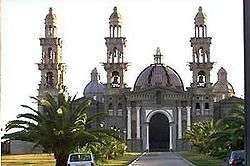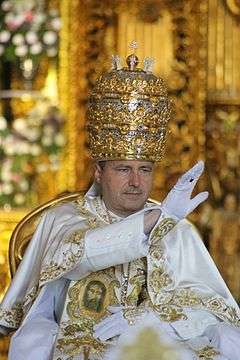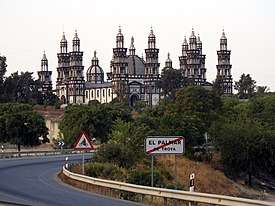Palmarian Catholic Church
The Christian Palmarian Church of the Carmelites of the Holy Face (Spanish: Iglesia Cristiana Palmariana de los Carmelitas de la Santa Faz), officially One, Holy, Catholic, Apostolic and Palmarian Church, commonly called the Palmarian Catholic Church (Iglesia Católica Palmariana), is a small schismatic Traditionalist Catholic church with an episcopal see in El Palmar de Troya, Spain. Some periodists, essayists and ancient followers defined this organization as a sect.[1][2]
| Palmarian Catholic Church | |
|---|---|
| Spanish: Iglesia Católica Palmariana | |
 The cathedral of Palmar de Troya, the seat of the Palmarian Pope | |
| Abbreviation | PCC |
| Classification | Independent Catholic |
| Orientation | Traditionalist Catholic • Sedevacantism |
| Polity | Episcopal |
| Governance | Holy See of Palmar de Troya |
| Pope | Pope Peter III |
| Region | Andalusia, Spain |
| Language | Spanish |
| Headquarters | Cathedral-Basilica of Our Crowned Mother of Palmar, Palmar de Troya Andalusia, Spain |
| Founder | Clemente Domínguez y Gómez (as 'Pope Gregory XVII') Jesus, according to Palmarian tradition |
| Origin | August 6, 1978 Andalusia, Spain |
| Separated from | Roman Catholic Church (1978) |
| Congregations | 1 |
| Members | Claimed 1,000 to 1,500 (2011) |
| Clergy | Bishops: 30 Nuns: 30 (2015) |
| Other name(s) | One, Holy, Catholic, Apostolic and Palmarian Church Christian Palmarian Church of the Carmelites of the Holy Face |
| Official website | https://www.palmarianchurch.org/ |

The church regards Pope Paul VI, whom they revere as a martyr, and his predecessors as true popes, but hold, on the grounds of claimed apparitions, that the Pope of Rome is excommunicated and that the position of the Holy See has, since 1978, been transferred to their See of El Palmar de Troya.
The Palmarian Catholic Church has had four pontiffs since its establishment. Clemente Domínguez y Gómez (Pope Gregory XVII) declared himself pope in 1978 until his death in 2005; Manuel Corral (Pope Peter II) succeeded Domínguez in 2005 and led the church until his death in 2011. Corral was succeeded by Ginés Jesús Hernández (Pope Gregory XVIII) in 2011. Hernández resigned in 2016 to marry and was succeeded by Joseph Odermatt (Pope Peter III) in 2016.
History
Origins
In March 1968, four Spanish schoolgirls (only known as Ana, Josefa, Rafaela and Ana María) stated they saw an apparition of the Virgin Mary by a little tree on a piece of farmland called La Alcaparrosa near Palmar de Troya. The apparition became known as Our Lady of Palmar. Many people came to witness the supposed apparitions, and a number of miracles similar to those alleged to have happened at Fátima, Garabandal and Međugorje were said to have occurred. The seers had many supporters, including priests. Several other people reported visions at the site, including Clemente Domínguez y Gómez, an office clerk from Seville. He gradually became the "principal seer".[3][4]
The original seers' visions were dismissed by the local bishop. They returned to their normal lives and have allegedly said they wished only to forget the past and to have no connection with the Palmarian Church.[5] Domínguez claimed that the Virgin Mary had given him instructions to rid the Catholic Church of "heresy and progressivism", and of Communism.
In 1975, Domínguez formed a new religious order, the Order of Carmelites of the Holy Face, which claimed to be "faithful to the holy Pope Paul VI". It claimed that Paul VI was detained in the Vatican by evil conspiring cardinals. The order was initially run by laymen, but supported sacramentally by priests from Spain, Portugal, and the United States.
Consecration of bishops
To be guaranteed access to the sacraments, Domínguez's group needed its own bishops. Domínguez wrote a letter to Marcel Lefebvre and asked him to consecrate him, but Lefebvre declined the offer and told them to contact a traditionally-minded Vietnamese bishop instead. In 1976, Swiss priest Maurice Revaz (who had taught Canon Law at the Society of Saint Pius X (SSPX) seminary in Ecône) persuaded the elderly Vietnamese Archbishop Ngô Đình Thục of the authenticity of the apparitions.[6] Thục was chosen because he was a papal legate. Accepting the mystical message of the seer-mystics, the Archbishop believed that he was called by the Virgin Mary to raise two of the order's members (Clemente Domínguez and a lawyer named Manuel Alonso Corral) and three of the priests associated with the group to the rank of bishop. Thục also ordained some laymen to the priesthood. Clemente Dominguez had a "vision" while Archbishop Thục was present. During the vision, Clemente proceeded to take the child Jesus, who had apparently appeared in the vision and placed the Child Jesus in the Archbishop's arms. This seems to have convinced Thục of the authenticity of the apparitions and confirmed his decision to ordain and consecrate in El Palmar de Troya in 1976.
Archbishop Thục acted without obtaining the mandatory authorisation from the Holy See, and he and the five men he consecrated as bishops were subsequently excommunicated by Paul VI. Thục subsequently cut his ties with the group and was reconciled with the Church authorities.
Gregory XVII: Claim to the papacy
Following the death of Paul VI in 1978, Domínguez claimed that he had been mystically crowned pope by Jesus Christ in a vision. This reported vision took place in Santa Fe de Bogotá in Colombia, on the 6th of August 1978. He took the papal name Gregory XVII, and appointed his own cardinals. By these actions, the "Carmelites of the Holy Face" evolved into the Palmarian Catholic Church. Some Catholics previously associated with the Carmelites left the group as a result.
The popes of the Palmarian Church do not claim to be the titular bishop of Rome. Rather, they claim that Christ transferred the position of Patriarch of the West and Supreme Pontiff to the new episcopal see of El Palmar de Troya. This is a departure from traditional Catholic doctrine, which identifies the papacy with the bishop of Rome. Catholic teaching also holds that personal revelations are not binding on the Church as a whole.
In his capacity as pope, Domínguez ("Pope Gregory XVII") called the Catholic Church a false church and declared Pope John Paul II excommunicated. Gregory XVII canonized the explorer Christopher Columbus, General Francisco Franco and founder of Opus Dei Josemaría Escrivá; and declared Paul VI a martyr or saint with Palmarian Catholic faith. He survived a car accident, in which he lost his sight in both eyes, and remained pope.
Peter II
Domínguez died in March 2005, according to Palmarian sources, supposedly experiencing a vision during an Easter Liturgy. His successor as pope immediately elevated Domínguez to be Pope Saint Gregory XVII the Very Great. Manuel Alonso Corral, named in 2000 by Domínguez as his successor, succeeded him as Peter II. There was no Palmarian conclave for this election.
Peter II made no claims to visions but stated that the Antichrist was born in the year 2000. Palmarian doctrine indicates that the Antichrist will mock Christ and imitate him by making a public appearance at age of 12, i.e. c. 2012, and begin his public life in 2030, when he is 30 years old.
Peter II died on July 15, 2011 after a long illness.[7]
Gregory XVIII
Peter II was succeeded in 2011 by his Secretary of State, Ginés Jesús Hernández, who took the name Gregory XVIII. He resigned the papacy on April 22, 2016. Earlier known as a hardliner, making several rules much stricter, towards the end of his papacy, he abolished some of them.[8] Hernández resigned from his papacy on 22 April 2016 to marry Nieves Trivedi, and was succeeded on 23 April 2016 by Odermatt who took Peter III as his papal name. Hernández also reverted into Roman Catholicism once again.
Peter III
After the resignation of Gregory XVIII, a new pope was crowned in the Palmarian Church on April 23, 2016. As expected it was Joseph Odermatt, who was previously Gregory XVIII's Secretary of State. Odermatt adopted the papal name Peter III.[9]
Present day

In a sermon delivered in August 2011, Gregory XVIII said that the Palmarian Church had between 1,000 and 1,500 members, but in the following years many were excommunicated. In 2015 the number of bishops was probably down to about 30 and the number of nuns were around 30, too. According to Magnus Lundberg, "except for at the very beginning, most new members were children of Palmarian couples and not people coming from outside." As of 2015, 32 bishops remained out of 192 men who were consecrated as bishops between 1976–2015, according to Lundberg.[10](p27)
Since 1983 the Palmarian Church has drastically reformed its rites and its liturgy, which previously had been styled in the Tridentine form. The Palmarian liturgy was reduced to almost solely the Eucharistic words of consecration. The See of El Palmar de Troya has also declared the Real Presence of the Virgin Mary in the sacred host and the bodily assumption into heaven of St. Joseph to be dogmas of the Catholic faith. By 2000, they had their own Palmarian version of the Bible, revised by Domínguez on claimed prophetic authority and a product of the Second Palmarian Council, also known as the Palmarian synod. For these reasons and their strict rules allowing no communication with people outside of the faith, other Catholics consider the Palmarian Church to be heretical and a cult.
The Archidonian Palmarian group (Archidona, Malaga, Spain) formed in 2000 was due to the expulsion of 16 cardinals and five nuns. They were expelled by Domínguez for diverse reasons. The predominant reason for the expulsions was due to Domínguez's belief that there was "a church within a church" planning to overthrow or assassinate him. The group in Archidona has since almost disbanded and there remains four or five. They presently call themselves "independent" Palmarian priests. They believe that the see of Peter is once again vacant.
Saints
Saints canonized by the Palmarian church include Christopher Columbus, Francisco Franco, Francisco Jiménez de Cisneros, José Antonio Primo de Rivera, José Calvo Sotelo, Josemaría Escrivá, Luis Carrero Blanco, Pelagius of Asturias,[11][12] and 300,000 martyrs of the Spanish Civil War.
An internet hoax claiming that the Palmarians had canonised Adolf Hitler originated on a fabricated Palmarian blogging site and was disseminated through Wikipedia and other media;[13] the Palmarian church has denied the claim.[14] According to the religious studies scholar Magnus Lundberg, the leadership of the Palmarian church treat the continued spread of the hoax as evidence that the media and the internet have been coopted by enemies of the church.[13]
Palmarian Popes
Palmarian Catholics generally accept the conventional succession of Catholic Popes up to Paul VI (r. 1963–1978) but reject the conventional succession after him. As of 2017, none of Gregory XVII's successors have been elected by a Palmarian conclave, but were appointed as successors by the previous pope.
| Papal name | Personal name | Pontificate |
|---|---|---|
| Gregory XVII | Clemente Domínguez y Gómez | 15 August 1978 – 22 March 2005 (26 years) |
| Peter II | Manuel Alonso Corral | 22 March 2005 – 15 July 2011 (6 years) |
| Gregory XVIII | Sergio María Ginés Jesús Hernández y Martinez | 23 July 2011 – 22 April 2016 (5 years) |
| Peter III | Joseph Odermatt | 23 April 2016 – present (4 years) |
Headquarters
The church's walled compound, near the village of El Palmar de Troya, surrounds the Cathedral-Basilica of Our Crowned Mother of Palmar which contains the Palmarian popes' cathedra and at least 15 altars.[15](pp4, 32–33, 36)[16]
In popular culture
- The Palmarian Church plays a major role in Dan Brown's 2017 novel Origin.
- The events around the foundation of the church are depicted in the 1986 Spanish film Manuel y Clemente.[17][18]
See also
References
- "¿El declive de los falsos Papas?". El Correo de Andalucía. 23 July 2011.
- Lundberg, Magnus (2015). "Palmar de Troya: Holy Catholic Apostolic Palmarian Church" (PDF). Partnership for Understanding World Religions and Spirituality at Virginia Commonwealth University. Richmond, VA. Archived from the original (PDF) on 2016-04-06.
- Corrales, Scott. "A tale of two popes". wintersteel.homestead.com. Inexplicata, A Journal of Hispanic Ufology. Retrieved 2008-07-01.
- Corrales, Scott (2005-04-13). "A tale of two popes: Scott Corrales on the late Gregory XVII of El Palmar de Troya". Archived from the original on 2016-04-06. Retrieved 2013-06-26 – via Yahoo Groups.
- Duncan, Robert (2007-10-05). "Spain's Pope Gregory XVII: a profile Of madness". speroforum.com. Houston, TX: Spero News. Retrieved 2008-07-01.
- Schmitt, Oskar (2006). Ein würdiger Verwalter im Weinberg unseres Herrn Jesus Christus: Bischof Pierre Martin Ngô-dinh-Thuc. Norderstedt: Books on Demand. ISBN 9783833453854.
- "Recent Popes – Iglesia Catolica Palmariana". www.palmarianchurch.org. Retrieved 2019-04-17.
- Lundberg, Magnus (2016-05-01) [first posted 2016-04-22]. "The Palmarian Pope has resigned and is succeeded by Peter III". magnuslundberg.net (blog). Uppsala, Sweden: Magnus Lundberg. Archived from the original on 2016-05-03. Retrieved 2016-05-03. (Content has been added since the first posted date)
- "His Holiness Pope Peter III – Iglesia Catolica Palmariana". www.palmarianchurch.org. Retrieved 2019-04-17.
- Lundberg, Magnus (2015). "Modern alternative popes" (PDF). uu.diva-portal.org. Uppsala University Library. Archived (PDF) from the original on 2016-04-06. Retrieved 2016-04-06.
- Macías, Javier (2015-01-03). "En el interior de la iglesia del Palmar de Troya". sevilla.abc.es (in Spanish). Seville, ES: Diario ABC S.L. Archived from the original on 2016-06-02. Retrieved 2016-04-28.
- Martín-Arroyo, Javier (2016-05-26). "The Palmarian Catholic Church: a lie that lasted 40 years". elpais.com (English ed.). Seville, ES: El País. Archived from the original on 2016-05-27. Retrieved 2016-08-16.
- Lundberg, Magnus. A Pope of their Own: El Palmar de Troya and the Palmarian Church (PDF). pp. 175–177.
- "Lies and Calumnies". Official Website of the Order of the Carmelites of the Holy Face in company with Jesus and Mary.
- Lundberg, Magnus (c. 2015). "Palmar de Troya: Holy Catholic Apostolic Palmarian Church" (PDF). wrs.vcu.edu. Richmond, VA: Partnership for Understanding World Religions and Spirituality at Virginia Commonwealth University. Archived (PDF) from the original on 2016-04-06.
- Garvey, Geoff; Ellingham, Mark (2009). Andalucía (6th ed.). London: Rough Guides. p. 335. ISBN 9781843530688.
- Olson, Jenni, ed. (1996). "Manuel y Clemente". The ultimate guide to lesbian & gay film and video. New York: Serpent's Tail. ISBN 9781852423391.
Manuel and Clemente, lovers and employees of a church-owned insurance company, dream of being successful in life and ... see their chance; posing as a 'prophet', ...
- Murray, Raymond (1998). "Manuel and Clemente". Images in the dark: an encyclopedia of gay and lesbian film and video (Rev. and upd. ed.). London: Titan Books. p. 494. ISBN 9781840230338.
... based on the history of the Carmelites of the Holy Shroud sect. Two gay lovers cash in on the religious prophesy racket in a scam that culminates with Clemente's coronation as Pope.
- The original version of this article was adapted from Wilkinson, Isambard (2003-05-05). Written at Madrid. "A million gather for Pope's 'last words' to Spain". telegraph.co.uk. London: Telegraph Media Group Limited. Archived from the original on 2016-04-20.
- A Pope of their Own: El Palmar de Troya and the Palmarian Church (2017 book on the Palmarians [2nd edition, 2020] by Prof. Magnus Lundberg, Uppsala University)
- Information about Pope Gregory XVII
- Rules governing the followers of the Palmarian church (Support and information for those affected by Palmarians)
- The Holy Apostolic Catholic Palmarian Church (Profile with a timeline – from Partnership for Understanding World Religions and Spirituality at Virginia Commonwealth University)
- Palmar de Troya-Holy Catholic Palmarian Church (report by Magnus Lundberg, Uppsala University)
- A visit to the Basilica of Palmar de Troya (Ex-Palmarian nun revisits the Basilica compound in 2007 and 2016)